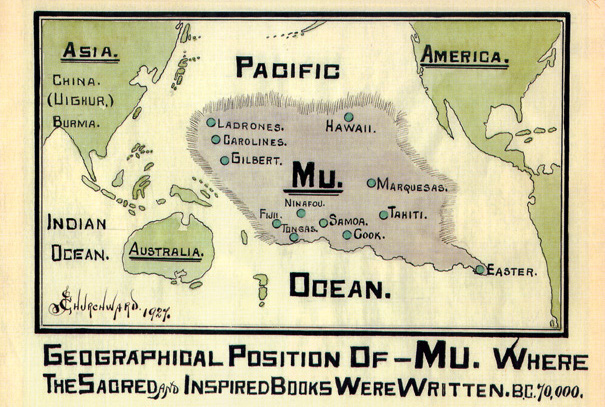
The deluge and the lost continent of Mu
- Matthieu P.J.
- Spirituality
- February 4, 2024
The Swastika, most revered symbol of Mu
Table of Contents
Ancient Apocalypse
Ancient Apocalypse is a 2022 series released on Netflix, where British writer Graham Hancock explains his theory of an ancient global advanced civilisation that has gone extinct brutally but left traces all over the world. When you see the emotional intensity of the reactions of people on the internet about that series, it makes you realise Hancock has really touched a sensitive point for many.
Granted, this controversial documentary does not align with the scientific dogma, but is that why his author should be ridiculed? Well, he’s used to it because his 1995 book Fingerprints of the Gods already triggered much passion back then. Worse, his BBC documentary of the same decade was cut in a way that discredited him. Hancock was a reporter for decades and is well travelled. So much so that he couldn’t help noticing troubling similarities in civilisations stretched all over the world, at a time when they were not supposed to have communications with each other. Is that not troubling? Instead of seriously considering the far reaching consequences of this topic, many go onto a witch hunting after Hancock and the ‘conspiracy theorists’ and buzzwords such as pseudoscience abound. Just because science has not ‘proven’ something yet, it doesn’t mean it is not true! The lack of open-mindedness of some is troubling me more than the man who—granted with some bitterness resulting from past hurts—is trying to point out that there are scenarios we should seriously consider.
History has taught us that collectively we could be really wrong about certain things; and that there were many instances when the immense majority of people living believed in lies. Think: the earth orbiting the sun, the existence of the Americas, flying planes etc. The following generations then normalise new knowledge and take it for granted. But, what if today we are still believing in lies? Could you expect people to embrace alternative scenarios to what we take as true today? Absolutely not! History teaches us that change is never an easy journey. Back in the days you could burn at the stakes for defying the status quo. Today? You can get ridiculed and your career destroyed.
So what is Hancock talking about here exactly? There are pyramids on all continents. There are temples with astronomical alignments pointing to the sun rising or setting on the equinoxes or solstices. There are myths very similar all over the world that talk about a deluge that destroyed nearly all men on earth and that then civilisation was brought by ‘gods’ who taught the men everything to know. Why those patterns? Could it be that something really happened in the past to explain that? The answer is a big YES!
Hancock’s theory is that a master civilisation once ruled the earth and had colonies all over it. Each colony embedded a bedrock of shared knowledge from the master civilisation in their own culture and flourished. Until… the deluge came. That global destruction by water called the deluge was caused by a comet coming close enough to the earth to cause a fall of meteorites at a large scale. A catastrophic event that had tremendous effects on the weather and left an imprint in the collective unconscious to this day. The deluge occurred about 13,000 years ago and too many findings agree on that particular date to dismiss it. But it was so long ago that it removes all absolute certainty about it happening. After all, we can’t even agree on what happened some 50 years ago, so imagine 13,000!
Hancock goes all over the world to ancient temples and complexes and tries to get a date for their construction. But he can’t know for sure. Why? Because the structures are made of stone, and stone cannot be dated. Well, it has a geological age of millions or billions of years but it doesn’t tell you when it was assembled. And that’s an uncertainty we have to accept. Carbon dating is using organic remains to give a date. And just because people live on a site doesn’t mean they’ve built it! It’s so obvious and compelling that it’s probably irritating for many to hear, but that is the truth. I used to live in a 1900 Victorian house in London, but that doesn’t mean I built it, I just happened to have lived there many years after it was erected. What about temples built in times immemorial and used by later civilisations? There’s no difference in principle, only in timescales. So there’s really something going on here. Hancock likes to say: “we are a species with amnesia” and I know he’s right. We are living in amnesia of what just the previous generation has done wrong, and we repeat mistakes miserably because our forerunners are dead and their wisdom was not passed on and forgotten. When I see that, it’s not hard at all to imagine that we have forgotten things from our distant past. Well, the masses have, but the knowledge was kept secret by a few for the benefit of the collective, until it could resurface safely again. And I believe the time is now.
The lost continent of Mu
So, who was that master civilisation you may ask? There are many theories out there, and I’ll share what sounds true to me. I believe Atlantis for example was only a colony of the master civilisation, although one of its most successful ones. No, the master civilisation originated from somewhere else, a continent now lost called Mu. And that is not Lemuria either, just Mu.
Where was Mu? Surprise, surprise, Mu was located where an abnormally large ocean now sits: the Pacific. Mu extended to the north until Hawaii, to the south-west to the Fijis, and to the south-east up to Easter Island. Those 3 locations are merely remnants of the lost continent that was truly enormous.

Map of Mu by James Churchward (1927)
A highly advanced civilisation was based there a long time ago. We’re talking maybe 50,000 years ago, if not 100,000 years ago or even more. Such timescales are beyond what we can comprehend considering our relatively short written history period. The civilisation of Mu used to spread all over the world. Beings of immense power, unknown to modern man, lived there with lifespan lasting thousands if not tens of thousands of years. You may dismiss it as a fancy fiction, but there are some among us who remember it. A lost paradise, that collapsed during the Great Fall of Consciousness , which coincides with the famous deluge Hancocks talks about. Around the same time, the sinking of the continent took place, likely along with the shift of the earth pole and its orbit around the sun. A cataclysmic series of events that marked the reboot of humanity and the great amnesia.
But Mu is not lost to all, because its legacy survived. One symbol, in particular, survived: the Swastika (as pictured above). That ancient symbol that has travelled across the world and across millennia. A symbol of great power. So much so that in the 20th century a regime knowingly perverted it for its own dark agenda. You know of who I speak, don’t you? Hitler was not just a tyrant on the path to madness, he was a mystic and knew about ancient history. In an act of dark magic, he distorted the symbol and made it the one of his movement. The Swastika, taken as a mirror image and rotated 45 degrees became associated with the greatest horrors. And that is how ancient knowledge was dishonoured and vilified.


